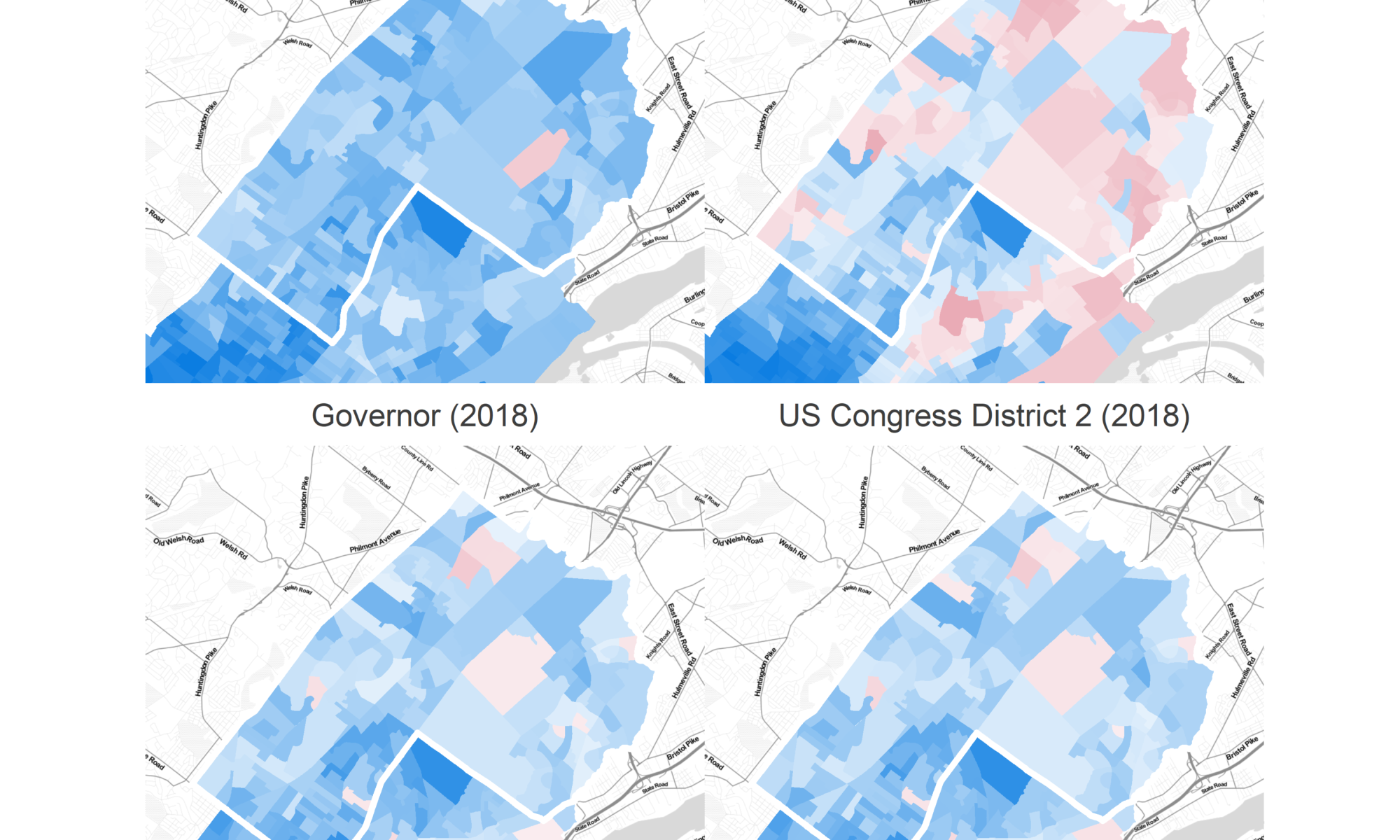TLDR: No.
On August 25th, I finished my analysis on whether a third party could win a Council At Large seat. I was surprised at how hard it would be for any of them to reach the ~35K votes necessary to win a seat. A candidate would have to perform twice as well as the best third party candidate in recent history, Andrew Stober. This would mean taking how he did in his single best division, and performing that well on average across Center City, its wealthy progressive ring, and the Northwest. It seemed unrealistic.
The day after I published my piece, Helen Gym endorsed Kendra Brooks of the Working Families Party. Then the October filings showed that Brooks had nearly doubled the donations of the highest GOP fundraiser. She’s generated a buzz that makes it seem like maybe, just maybe, the impossible could happen. We’re officially in outlier territory, and analyses of historical data have a hard time with outliers.
She’s generated so much buzz, in fact, that some Philadelphians are apparently wondering if one of the Democrats could lose? Could Brooks and her WFP co-candidate O’Rourke split the vote, siphoning off enough votes that one of the five Democrats loses a seat?
No. That is not going to happen.
There are three reasons this isn’t even a remote possibility:
Democrats’ dominance means that they would need to lose more than 55% of their votes to lose the seat.
A Democrat losing would require three candidates doing impossibly well, not just two.
The existence of echo chambers means the surge isn’t as large as you think.
This piece largely uses the same analyses I wrote about in August (so no code). But instead of asking whether a third party could win, let’s ask if a Democrat could lose.
Democrats’ dominance of recent elections
Democrats more than doubled the votes of the top vote-getting Republican in 2011. Then they more than tripled it in 2015. 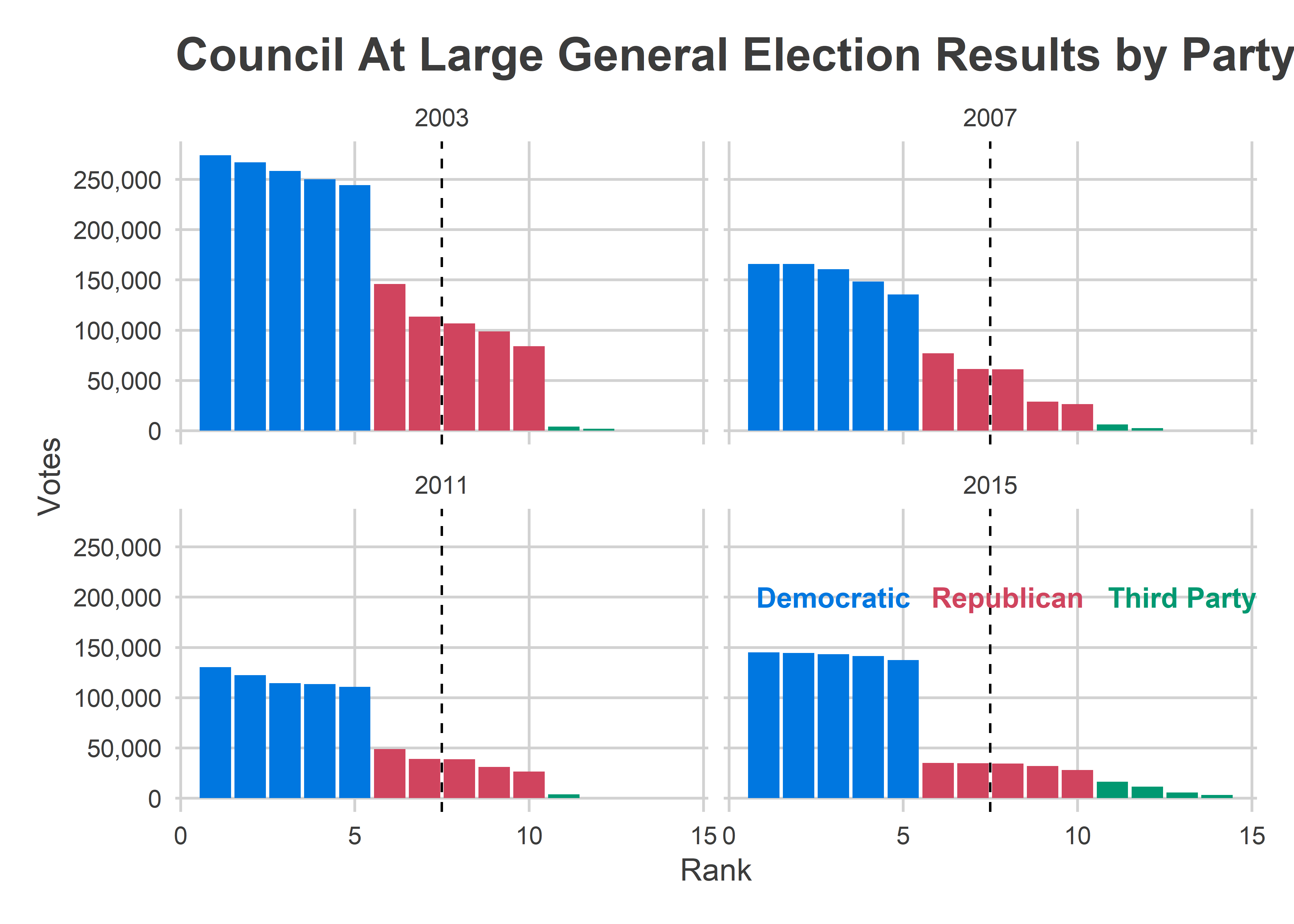
The scale of plausible votes for Brooks wouldn’t even dent that margin. The best showing of a third party candidate was 2015’s Andrew Stober, who received 16,301 votes. That was less than half of the 34,711 received by Al Taubenberger, the 7th and final At Large winner.
The gap between Democrats and that third Republican is more than double that. Consider 2011, since 2015 showed even more Democratic dominance than usual. In 2011, Greenlee was the fifth Democrat in with 110,544 votes. The seventh place vote-getter was David Oh, with 38,835.
Now, suppose Kendra Brooks time travels back to 2011 and runs for Council At Large. In order for Greenlee to lose to Oh, he would need to lose 70,000 votes. That would mean (a) Brooks would have to win those 70,000 votes, more than four times what Stober did in 2015, and (b) that every single one of those votes would need to come from Greenlee, instead of any of the other four Democrats. More realistically, Brooks’ voters would probably cast their other votes for a handful of the Democrats, so that a fraction of her votes were cannibalized from each of the candidates. And even if Brooks’ voters all bullet voted for her (ignoring my not-yet-written advice against it), it would take 70,000 bullet voters to make Greenlee lose.
It would take three strong insurgents, not just two
This is a simple point that most people overlook. For a Democrat to lose, they would have to lose to three candidates, not just two.
Suppose Brooks and O’Rourke did unprecedentedly well, each received 100,000 votes, and ended up beating a Democrat. That candidate would still finish seventh, and would still be sworn in as a Councilmember in January.
To lose, that Democrat would have to lose to three candidates, not just two, and finish in eighth. Given the contours of this election, that means that a Democrat losing to both WFP candidates isn’t enough; they’d also have to lose to a Republican. While there may be evidence that the WFP is doing surprisingly well, there’s none that the Republicans are performing any differently from usual. The top Republican of 2011 was Dennis O’Brien with 49,000 votes, which would mean that Greenlee’s votes would have to fall by more than half, even in this (impossible) scenario where he loses to Brooks and O’Rourke.
The surge isn’t as big as you think it is
The topline numbers make it clear how hard it would be for a Democrat to lose. But still, Brooks has received more money and generated more buzz than any recent third party candidate. We’re in outlier territory. Maybe she could get 70,000 bullet voters? I mean, we’re all talking about her, right?
No. You’re overestimating the surge.
I don’t have as good evidence for this point, but my lesson from the primary is that my social bubble just isn’t representative of the city as a whole. That’s why the DCC endorsees won handily, even though my twitter feed and the folks in my Wealthy Progressive University City neighborhood were talking about the progressive challengers.
The fact that you’re reading a datascience blog post about a Philadelphia Municipal Election means you’re not normal. You know who Kendra Brooks is, I think the majority of voters won’t.
Instead, most voters use heuristics to decide who to vote for, probably not thinking about it until the morning of Election Day. “Who represents my party?” “Who did my trusted source endorse?”
There’s nothing wrong with this. We’re all forced to pick from among the many things in life worthy of our attention. But it does mean that most voters will be operating by a heuristic that doesn’t help the Working Families Party: either “I always vote for the Democrat” or “My trusted Ward leader told me to vote this way.”
The logic adopted by the Working Families Party requires Democratic voters to (a) know that the Philadelphia Charter requires no more than five candidates come from the same party, (b) know that there is no chance a Democrat could lose so they should consider candidates on the margin, and (c) know about the Working Families Party and support its politics. None of this logic is wrong per se, but it’s a big ask, and requires substantial engagement from voters.
Instead, voters will probably use heuristics.
Voters from Black Wards appear particularly dedicated to the Democratic Party (for a breakdown of the neighborhood cohorts, see here). Here are results for recent progressive insurgent candidates, from 2015’s At Large General and Bernie Sanders’ and Larry Krasner’s primaries.
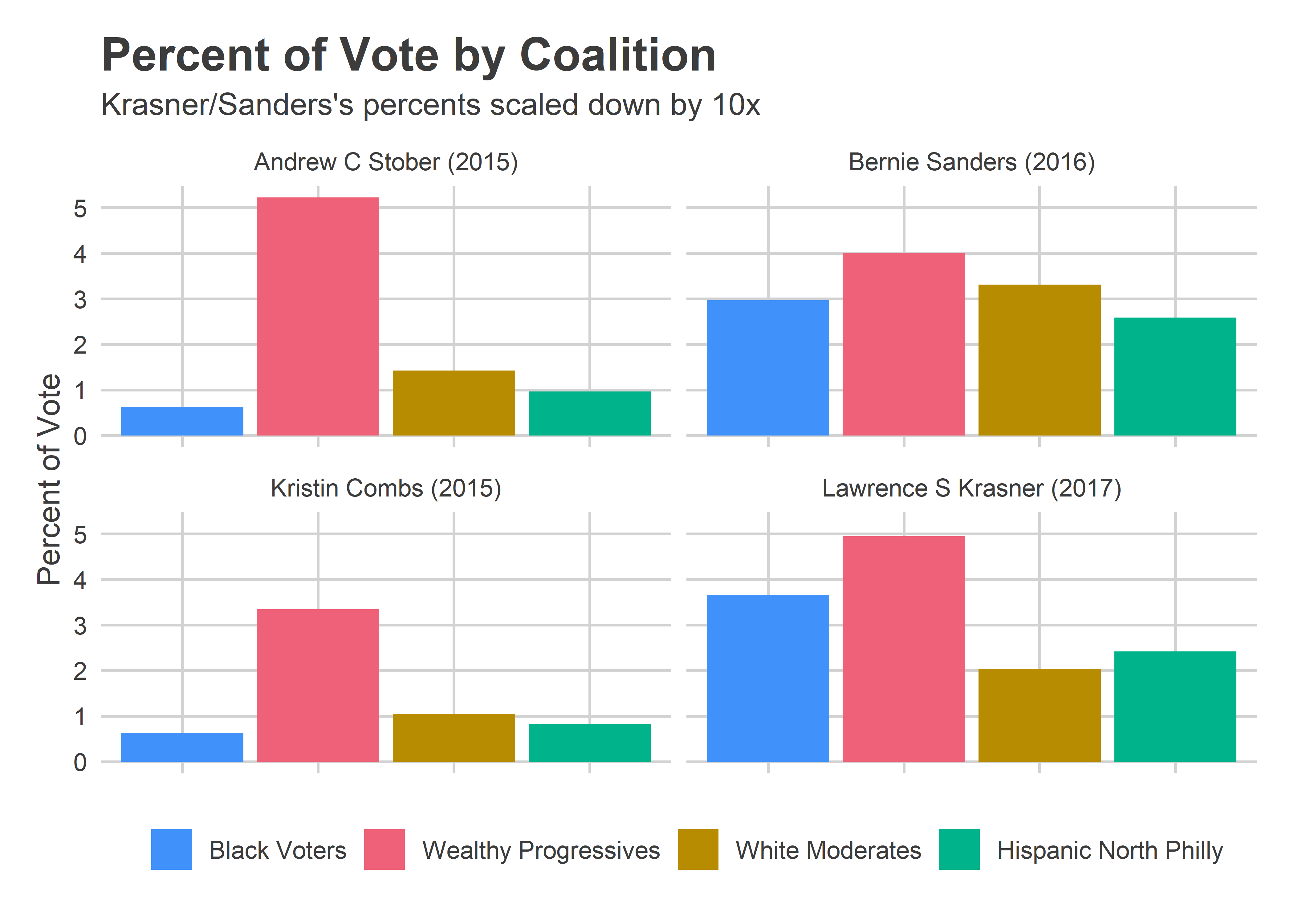
In 2015, third party candidates Stober and Combs were non-entities in Black Wards. Compare that to Sanders and Krasner. Black Wards supported them at nearly 75% the rate that Wealthy Progressive Wards did.
What were the differences between Sanders/Krasner and Stober/Combs? One I can measure, and two I can’t:
- Endorsements from Black Ward leaders. We can measure this: Krasner’s endorsements in the Northwest’s 10 and 50 alone were worth over 800 votes.
What about Brooks’ Inquirer endorsement? The problem for her is that the Inquirer’s endorsement has the biggest effect in exactly the Wealthy Progressive wards where she’s probably already doing best.
Another difference for Sanders and Krasner was the D next to their name. I can’t measure how important this is, but my guess is a lot. Brooks and O’Rourke don’t have it, and they’re all the way at the far end of the ballot.

Krasner and Sanders had significant buzz. They obviously broke through to voters’ awareness. Stober and Combs did not. Brooks is probably somewhere in between, not generating as much awareness as Krasner, but much more than any of 2015’s At Large challengers. That could help break through voters’ reliance on other Party recommendations.
Two of those three things help the Democrats in the Black Wards. And those Wards matter a lot. They represent more than 40% of the city’s votes, well beyond the share of the Wealthy Progressives, which will presumably be Brooks and O’Rourke’s base.
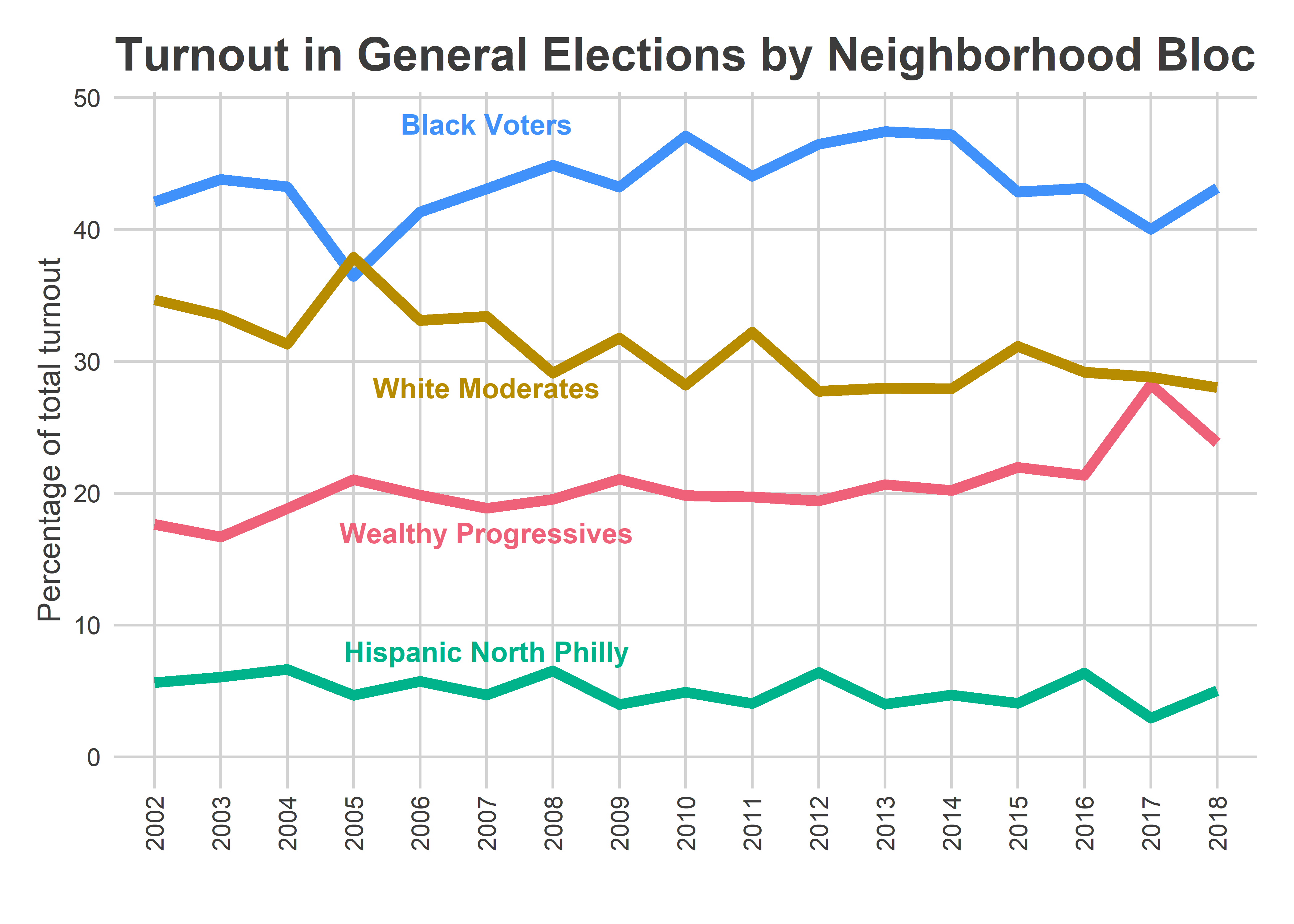
So while you feel like “everyone” is talking about Brooks and O’Rourke, remember that everyone was talking about Bernie, too. And he lost the city.
Conclusion: Could a Democrat lose?
No.
The Democrats have an untouchable margin of victory. Twice as large as a plausible vote count for Brooks.
Even if a Democrat lost to Brooks, they would still win a seat! They need to be beat by three people.
Usually when people think “this time is different,” they’re wrong. Maybe this time is different enough for a third party candidate to beat a Republican. It’s certainly not different enough for a Republican to beat a Democrat.
Could Brian O’Neill lose District 10?
Brian O’Neill has held the City Council seat for the Northeast’s District 10 since 1980. He’s the lone Republican in a Council District seat, in addition to the two Republicans who hold the reserved At Large seats.
After running unopposed in 2015, O’Neill is being challenged this November by Democratic candidate Judy Moore.
Could he lose?
In the the surprising Primary in West Philly’s District 3, the cohorts that would decide the race were clear. In District 10, it’s harder to say. Is O’Neill a beloved incumbent whose ability to cross party lines will ensure his victory? Or have all elections become nationalized, dooming even a city-level official in Philadelphia’s most Republican (but still Democratic) neighborhoods?
District 10
District 10 covers the farthest sections of the Northeast, stretching down to Fox Chase and Rhawnhurt.
View code
library(tidyverse)
library(sf)
library(ggmap)
source("../../admin_scripts/util.R")
sf_council <- st_read("../../data/gis/city_council/Council_Districts_2016.shp")sf_divs <- st_read("../../data/gis/2019/Political_Divisions.shp")df <- readRDS("../../data/processed_data/df_all_2019_09_05.Rds")
df <- df %>%
group_by(year, election, office, district, candidate, party, warddiv19) %>%
summarise(votes=sum(votes)) %>%
ungroup() %>%
mutate(party = ifelse(party == "DEMOCRAT", "DEMOCRATIC", party))
bb <- st_bbox(sf_council %>% filter(DISTRICT == "10"))
expand_bb <- function(x, factor){
mean_x <- mean(x)
return(mean_x + factor * (x - mean_x))
}
bb[c(1,3)] <- expand_bb(bb[c(1,3)], 1.2)
bb[c(2,4)] <- expand_bb(bb[c(2,4)], 1.2)
names(bb) <- c("left", "bottom", "right", "top")
basemap <- get_map(location=bb, maptype="toner-lite")
get_labpt_df <- function(sf){
df <- st_centroid(sf) %>%
mutate(
x=sapply(geometry, "[", 1),
y=sapply(geometry, "[", 2)
) %>%
as.data.frame() %>%
select(-geometry)
return(df)
}
phila_whole <- st_union(sf_council)
ggplot(sf_council) +
geom_sf(data=phila_whole, fill="white", color=NA) +
geom_sf(
fill=strong_green, color = "white", size = 1, alpha=0.5
) +
geom_sf(
data=sf_council %>% filter(DISTRICT == "10"),
fill=strong_green, color = "white", size = 1
) +
geom_text(
data = get_labpt_df(sf_council),
aes(x=x,y=y,label=DISTRICT)
) +
ggtitle("Philadelphia Council Districts") +
theme_map_sixtysix()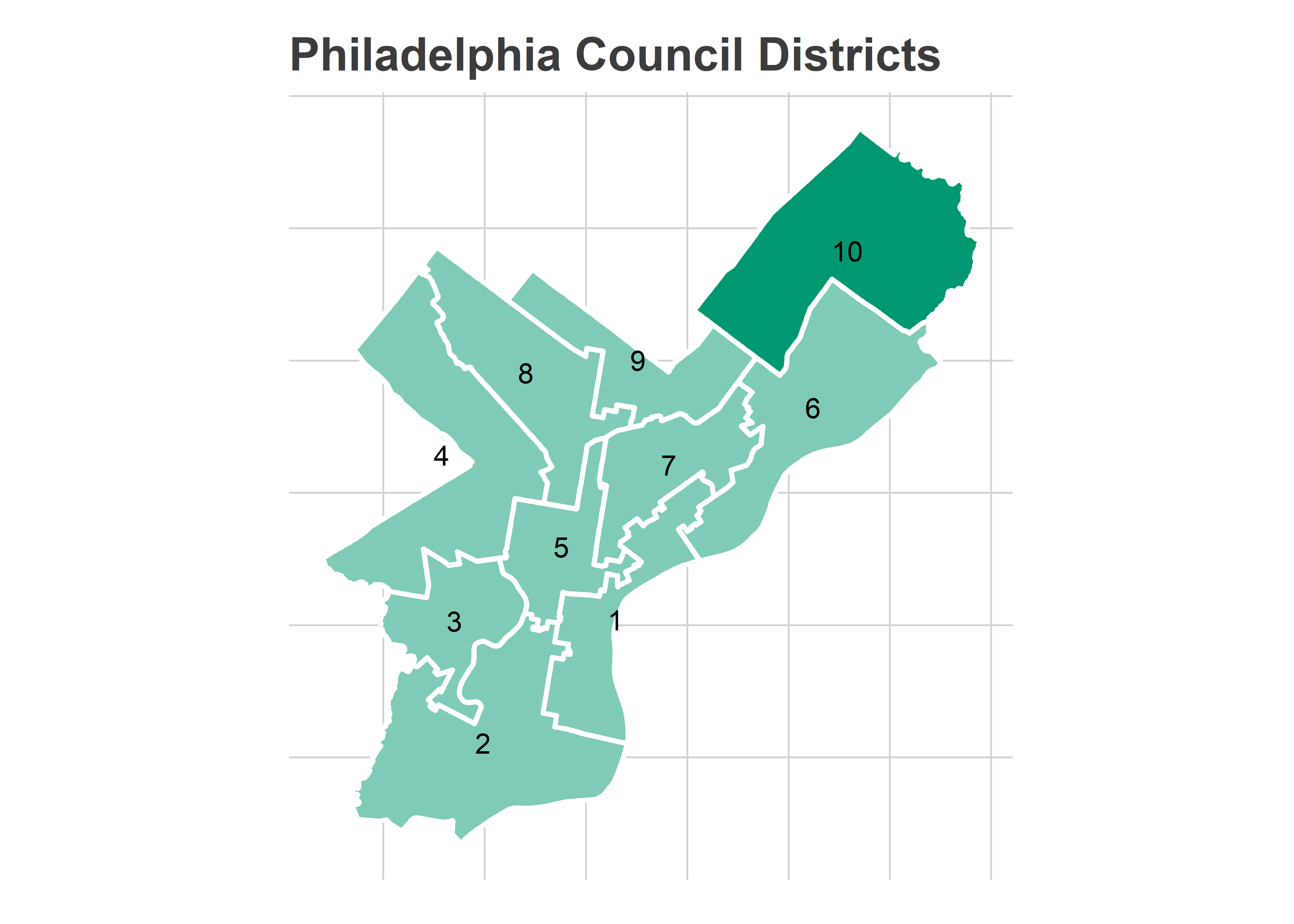
View code
district_map <- ggmap(
basemap,
extent="device",
base_layer = ggplot(sf_council),
maprange = FALSE
) +
theme_map_sixtysix()
sf_divs$council_district <- sf_divs %>%
st_centroid() %>%
st_covered_by(sf_council) %>%
(function(x){sf_council$DISTRICT[unlist(x)]})
district_map +
geom_sf(
aes(alpha = (DISTRICT == "10")),
fill="black",
color = "grey50",
size=2
) +
scale_alpha_manual(values = c(`TRUE` = 0.2, `FALSE` = 0), guide = FALSE) +
ggtitle(sprintf("Council District %s", 10))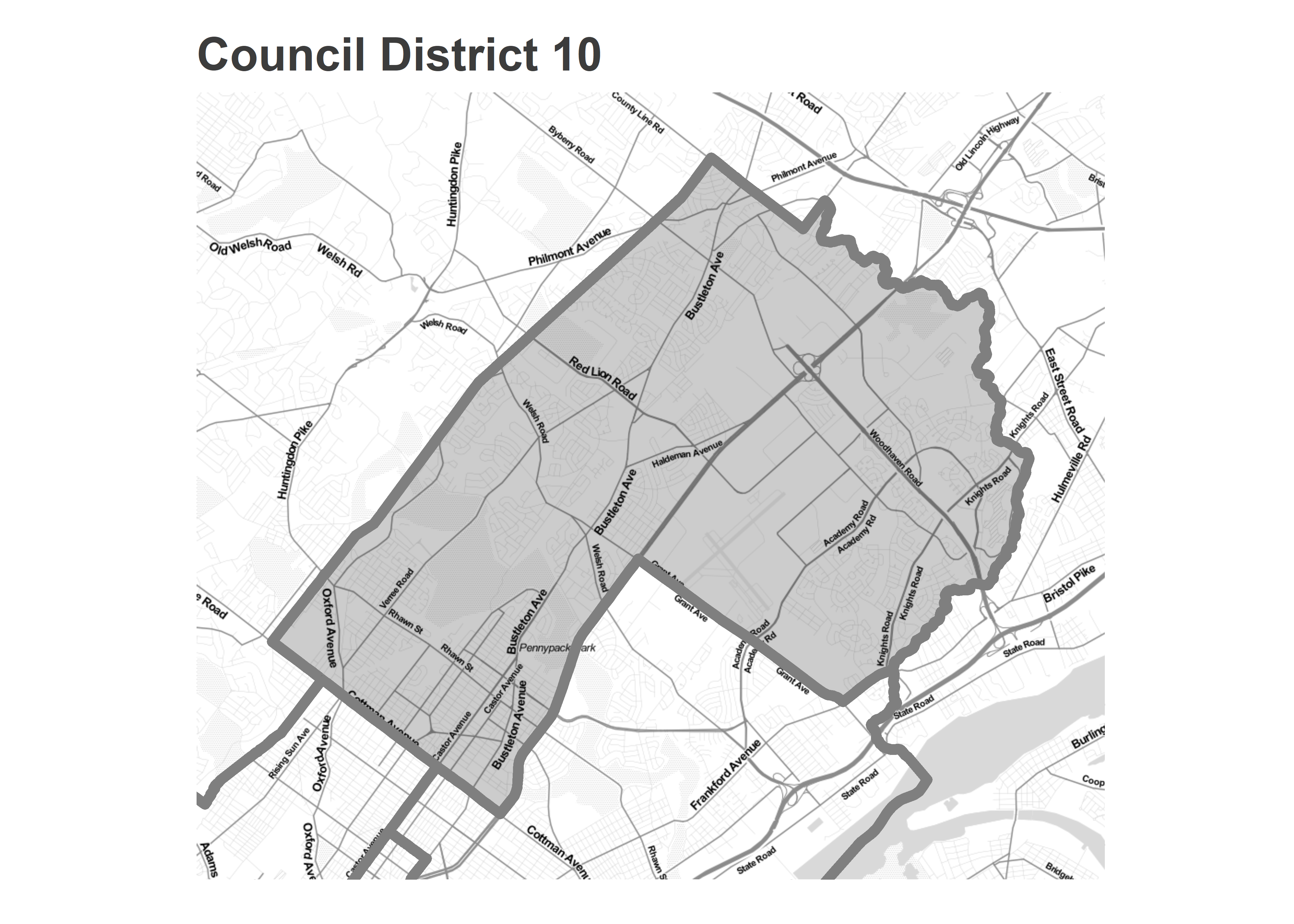
The district is consistently Philadelphia’s most Republican. It voted the most strongly for Trump (though Clinton still won overall), and is home to PA State Legislative District 170, represented by Republican Martina White.
(You can find all of these election maps, in interactive form, at the Ward Portal!)
View code
races <- tribble(
~election, ~office, ~district, ~short_office,
"general", "PRESIDENT OF THE UNITED STATES", NA, "President",
"general", "GOVERNOR", NA, "Governor",
"general", "REPRESENTATIVE IN CONGRESS", "2", "US Congress District 2",
"general", "MAYOR", NA, "Mayor"
# "2018", "general", "SENATOR IN THE GENERAL ASSEMBLY-2ND DISTRICT", "PA Senate"
)
candidate_votes <- df %>%
inner_join(races) %>%
group_by(warddiv19, short_office, year, election) %>%
mutate(
total_votes = sum(votes),
pvote = votes / sum(votes)
) %>%
group_by()
candidates_overall <- candidate_votes %>%
group_by(short_office, year, election, candidate, party) %>%
summarise(votes = sum(votes)) %>%
group_by(short_office, year, election) %>%
mutate(
pvote = votes/sum(votes),
use = pvote > 0.05
) %>%
filter(use)
candidate_votes <- candidate_votes %>%
inner_join(candidates_overall %>% select(year, election, short_office, candidate))
div_winners <- candidate_votes %>%
group_by(year, election, short_office, warddiv19) %>%
summarise(
winner = candidate[which.max(votes)],
winner_party = party[which.max(votes)],
winner_pvote = pvote[which.max(votes)],
twoparty_pvote = pvote[which.max(votes)] /
sum(pvote[party %in% c("DEMOCRATIC", "REPUBLICAN")], na.rm=TRUE),
total_votes = total_votes[1]
)
sf_divs <- sf_divs %>% rename(warddiv19 = DIVISION_N)
sf_divs$in_bbox <- sapply(
sf_divs$geometry,
function(g) {
coords <- as.matrix(g)
any(
coords[,1] > bb["left"] &
coords[,1] < bb["right"] &
coords[,2] > bb["bottom"] &
coords[,2] < bb["top"]
)
}
)
ggraces <- sf_divs %>%
filter(in_bbox) %>%
left_join(div_winners) %>%
mutate(
winner_party = format_name(substr(winner_party,1,3)),
race=sprintf("%s (%s)", short_office, year)
) %>%
mutate(race=factor(race, levels=unique(race[order(year)])))
district_map +
geom_sf(data=phila_whole, fill="white", color=NA) +
geom_sf(
data=ggraces %>% filter(year %in% c(2015, 2016, 2018)),
aes(fill = winner_party, alpha=100 * 2 * (twoparty_pvote - 0.5)),
color=NA
) +
geom_sf(
data=sf_council %>% filter(DISTRICT == "10"),
fill=NA,
color="white",
size=1
)+
facet_wrap(~race) +
scale_fill_manual(NULL, values=c("Dem"=strong_blue, "Rep"=strong_red)) +
theme_map_sixtysix() %+replace%
theme(legend.position = "bottom", legend.direction = "horizontal") +
scale_alpha_continuous("Win Margin (%)") +
guides(alpha = guide_legend(override.aes = list(fill = strong_blue)))+
ggtitle("District 10's recent elections")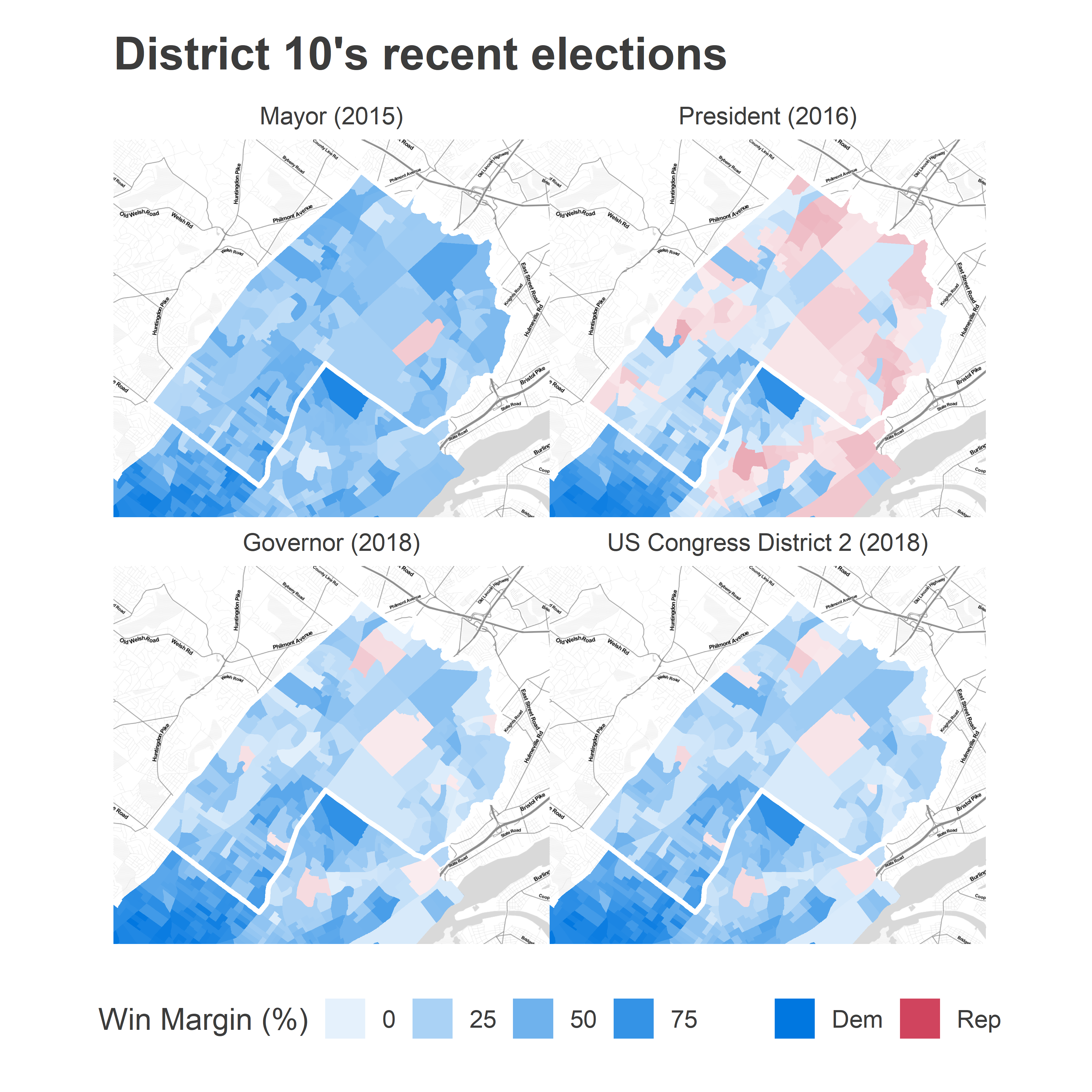
View code
sth_re <- "REPRESENTATIVE IN THE GENERAL ASSEMBLY"
sth_candidates <- df %>%
filter(
year == "2018", election=="general",
office == sth_re
) %>%
mutate(
party=format_name(substr(party,1,3))
) %>%
group_by(warddiv19, district, year, election) %>%
mutate(
total_votes = sum(votes),
pvote = votes / sum(votes)
) %>%
group_by()
sth_div_winners <- sth_candidates %>%
filter(party %in% c("Dem", "Rep")) %>%
group_by(year, election, district, warddiv19) %>%
summarise(
winner = candidate[which.max(votes)],
winner_party = party[which.max(votes)],
winner_pvote = pvote[which.max(votes)],
twoparty_pvote = pvote[which.max(votes)] / sum(pvote)
)
sf_sth <- st_read("../../data/gis/state_house/PaHouse2017_01.shp")sth_labpts <- sf_divs %>%
filter(in_bbox) %>%
left_join(sth_div_winners) %>%
group_by(district) %>%
dplyr::do(data.frame(geometry = st_union(.$geometry))) %>%
ungroup() %>%
mutate(geometry = st_sfc(geometry)) %>%
st_as_sf() %>%
get_labpt_df()
sth_labpts[sth_labpts$district=="170", c('x','y')] <- c(-75.02, 40.111)
sth_labpts[sth_labpts$district=="172", c('x','y')] <- c(-75.07, 40.079)
sth_labpts[sth_labpts$district=="173", c('x','y')] <- c(-75.002, 40.096)
district_map +
geom_sf(data=phila_whole, fill="white", color=NA) +
geom_sf(
data=sf_divs %>%
filter(in_bbox) %>%
left_join(sth_div_winners),
aes(fill = winner_party, alpha=100 * 2 * (twoparty_pvote - 0.5)),
color=NA
) +
geom_sf(
data=sf_sth, fill=NA, color="black"
) +
geom_sf(
data=sf_council %>% filter(DISTRICT == "10"),
fill=NA,
color=rgb(1,1,1,0.8),
size=2
)+
geom_text(
data=sth_labpts,
aes(x=x,y=y, label=district)
)+
scale_fill_manual(NULL, values=c("Dem"=strong_blue, "Rep"=strong_red)) +
theme_map_sixtysix() %+replace%
theme(legend.position = "bottom", legend.direction = "horizontal") +
scale_alpha_continuous("Win Margin (%)") +
guides(alpha = guide_legend(override.aes = list(fill = strong_blue)))+
ggtitle("District 10's 2018 PA House elections")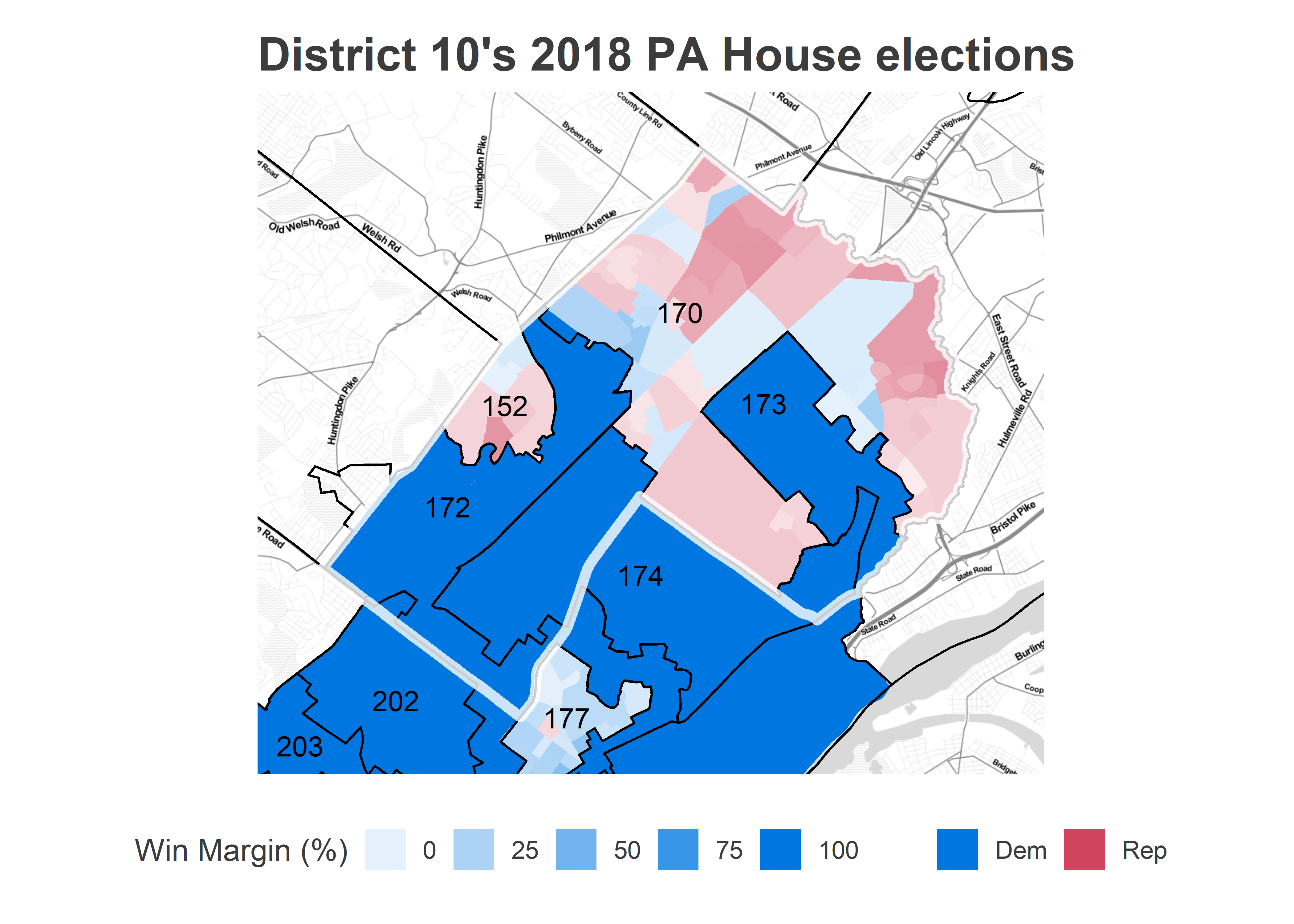
Many of the State House races were won by unopposed Democrats, with the two exceptions being Martina White’s 170, and the nub of Montgomery County’s 152. This makes it hard to project these races onto the District 10 race: how would those 100% districts have voted if there were a contest? There’s a big difference between if they would have gone 70% Democratic or 90%.
Recent races have varied in how divisive and how nationalized they were. In 2015, Kenney won broadly. The correlation between his performance and Clinton’s performance one year later was surprisingly weak. He won the district by 34 points, versus Clinton’s 5 point win, and won Divisions that Clinton lost handily.
View code
d10_scatter <- div_winners %>%
inner_join(sf_divs %>% filter(council_district == "10")) %>%
unite("office", short_office, year) %>%
mutate(
pdem_twoparty = ifelse(winner_party == "DEMOCRATIC", twoparty_pvote, 1-twoparty_pvote),
win_gap = 2 * 100 * (pdem_twoparty-0.5)
) %>%
select(office, warddiv19, win_gap, total_votes) %>%
gather("key", "value", win_gap, total_votes) %>%
unite(key, office, key) %>%
spread(key, value)
gap_labeller <- function(x){
sprintf(
"%s%s%%%s",
ifelse(x==0, "", "+"),
abs(x),
ifelse(x>0, " D", ifelse(x<0, " R", ""))
)
}
plot_scatter <- function(col, office, title){
col <- enquo(col)
ggplot(
d10_scatter,
aes(x=President_2016_win_gap, y=!!col)
) +
geom_abline(slope=1, intercept=0, linetype="dashed") +
geom_hline(yintercept=0, color="black") +
geom_vline(xintercept=0, color="black") +
geom_point(aes(size = President_2016_total_votes), alpha = 0.3, pch = 16) +
coord_fixed() +
theme_sixtysix() %+replace%
theme(legend.position = "right", legend.direction="vertical") +
scale_size_area("Votes in 2016") +
scale_x_continuous(
"Win Gap for President (2016)",
labels=gap_labeller
)+
scale_y_continuous(
sprintf("Win Gap for %s", office),
labels=gap_labeller
) +
ggtitle(title, "Division-level results")
}
plot_scatter(Mayor_2015_win_gap, "Mayor (2015)", "Kenney was popular even in Trump's Divisions")
In comparison, Brendan Boyle’s 24-point win was much more correlated with Clinton. I interpret this as the race being nationalized, with party affiliation becoming salient. The main question for November is if O’Neill is a Kenney-esque candidate, who transcends party and Northeasters will continue to support, or if all elections are nationalized in a post-2016 world.
View code
plot_scatter(`US Congress District 2_2018_win_gap`, "US Congress District 2 (2018)", "Boyle won a nationalized race")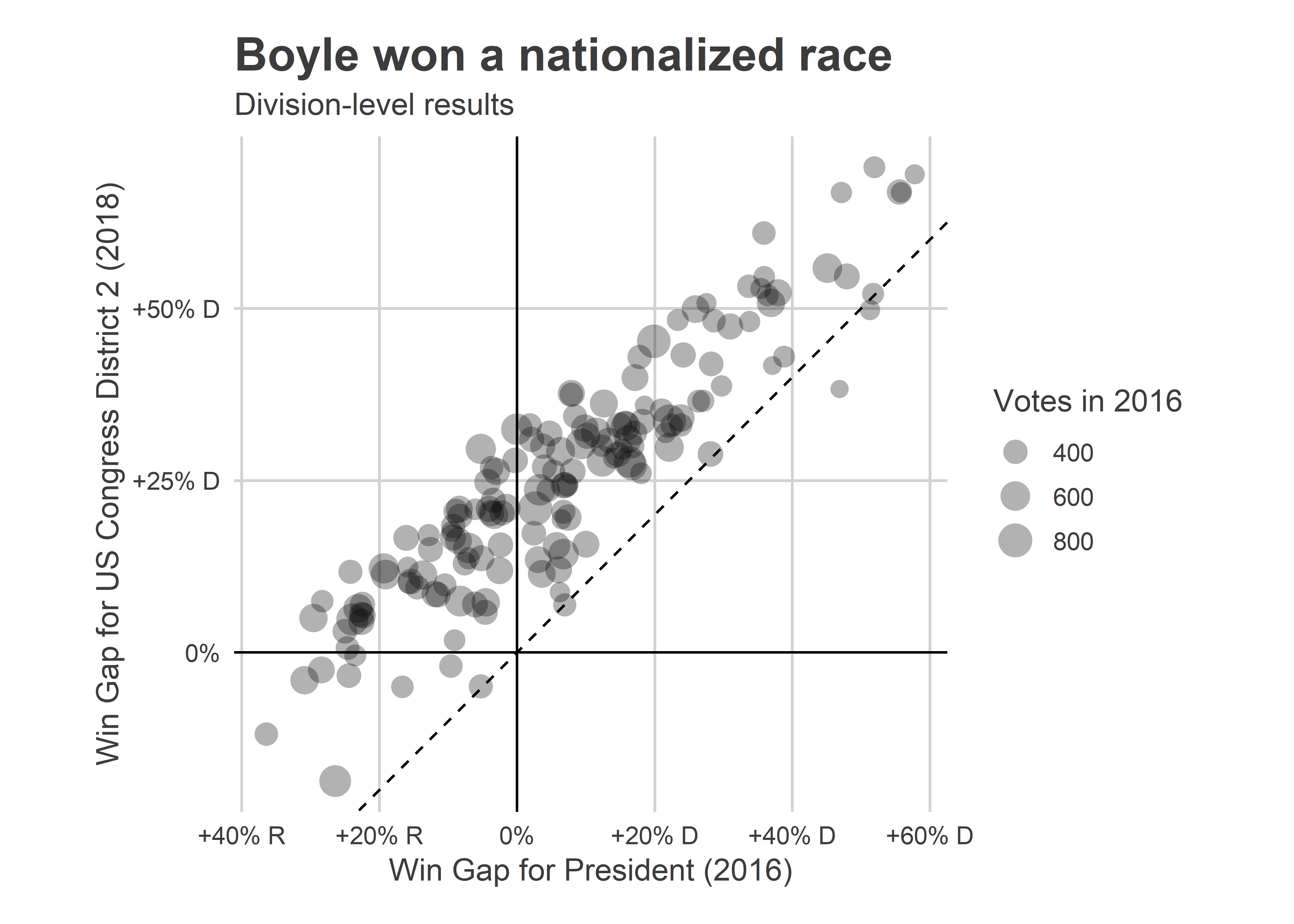
The challenge for Moore is that O’Neill consistenty runs ahead of every other Republican in the district.
Since 2003, there have been 21 uncontested District Council races. Only one of those was a Republican: O’Neill himself in 2015. So there’s not any history of uncontested Republicans to gain insights from.
View code
council <- df %>%
filter(election == "general") %>%
filter(office == "DISTRICT COUNCIL")
council_totals <- council %>%
filter(candidate != "Write In") %>%
filter(party %in% c("DEMOCRATIC", "REPUBLICAN")) %>%
group_by(year, candidate, party, district) %>%
summarise(votes=sum(votes)) %>%
mutate(is_competitive = votes > 100) %>%
group_by(year, district) %>%
summarise(
n_contested = sum(is_competitive),
winner = candidate[which.max(votes)],
winner_pct = votes[which.max(votes)] / sum(votes),
winner_party = party[which.max(votes)]
)
## council_totals %>% filter(winner_pct == 1)
oneill_df <- council_totals %>%
filter(district == 10) %>%
mutate(office = "Council", short_office="Council District 10") %>%
rename(prep = winner_pct) %>%
select(year, prep, short_office) %>%
bind_rows(
df %>%
filter(
office %in% c("MAYOR", "PRESIDENT OF THE UNITED STATES", "GOVERNOR"),
election == "general",
party %in% c("DEMOCRATIC", "REPUBLICAN")
) %>%
mutate(short_office = format_name(office)) %>%
inner_join(sf_divs %>% as.data.frame() %>% filter(council_district == 10) %>% select(warddiv19)) %>%
group_by(year, party, short_office) %>%
summarise(votes = sum(votes)) %>%
group_by(year, short_office) %>%
summarise(
prep = votes[party == "REPUBLICAN"] / sum(votes)
)
)
ggplot(
oneill_df ,
aes(x=asnum(year), y=2*100*(prep-0.5), color=short_office)
) +
geom_hline(yintercept = 00, color="grey20") +
geom_point(
size=3
) +
geom_line(
aes(group=short_office),
size=1
) +
theme_sixtysix() +
ylab("Percent for Republican") +
geom_text(
data=data.frame(
year=2015.2, prep=c(0.30, 0.95, 0.55, 0.4), label=c("Mayor", "O'Neill", "President", "Governor"),
short_office=c("Mayor", "Council District 10", "President of the United States", "Governor")
),
hjust=0, fontface="bold",
aes(label=label)
) +
scale_color_manual(
guide=FALSE,
values=c(
"Mayor"=light_blue,
"Council District 10"=light_red,
"President of the United States"=light_purple,
"Governor"=light_green
)
)+
xlab(NULL) +
scale_x_continuous(breaks = seq(2003, 2015, 4)) +
scale_y_continuous(labels=function(x) gap_labeller(-x)) +
ggtitle("O'Neill runs far ahead of other Republicans")
O’Neill ran 17 points ahead of the Republican candidate for Mayor in 2007 and 2011 (meaning a gap of 34 points). Then in 2015 he was unupposed. In thatDemocrats have won every single Presidential, Gubernatorial, and Mayoral race in the district since, with the only exception being voting for Katz over Street in 2003.
Comparative turnout in Municipal Elections
If the race becomes close, relative turnout of Republican and Democratic divisions might be decisive. The Republican divisions typically turn out more strongly in non-Presidential elections. Using turnout in 2016 as the baseline (my preferred method), very-Republican divisions had nearly 1.5 the relative turnout of the very-Democratic ones in 2015.
View code
turnout <- df %>% filter(
election=="general",
year %in% 2015:2018,
office %in% c("MAYOR", "GOVERNOR", "PRESIDENT OF THE UNITED STATES", "DISTRICT ATTORNEY")
) %>%
group_by(year, warddiv19) %>%
summarise(turnout=sum(votes))
turnout <- sf_divs %>%
as.data.frame() %>%
select(warddiv19, Shape__Are) %>%
left_join(turnout) %>%
group_by(year) %>%
mutate(
turnout_per_area = turnout / Shape__Are,
turnout_per_area_std = (
turnout_per_area - mean(turnout_per_area)
) / sd(turnout_per_area)
)
turnout_wide <- turnout %>%
select(-turnout_per_area_std) %>%
gather("key", "value", turnout, turnout_per_area) %>%
unite("key", key, year) %>%
spread(key, value) %>%
inner_join(sf_divs %>% as.data.frame() %>% filter(council_district == "10") %>% select(warddiv19))
turnout_scatter <- function(year, title){
turnout_col <- sym(paste0("turnout_", year))
ggplot(
turnout_wide %>% left_join(d10_scatter),
aes(
x=President_2016_win_gap,
y=100*!!turnout_col / turnout_2016
)
) +
geom_point(
aes(size=President_2016_total_votes),
alpha = 0.5, pch=16
) +
theme_sixtysix() +
geom_smooth(
aes(weight=President_2016_total_votes),
color = "black", method=lm
) +
scale_y_continuous(
sprintf("Votes in %s / Votes in 2016 (%%)", year),
breaks=seq(0,100,10)
)+
scale_x_continuous(
"Win Gap for President (2016)",
labels=gap_labeller
) +
scale_size_area("Votes in 2016") +
expand_limits(y=0) +
ggtitle(title)
}
turnout_scatter(2015, "Republican Divisions voted disproportionately\n in 2015")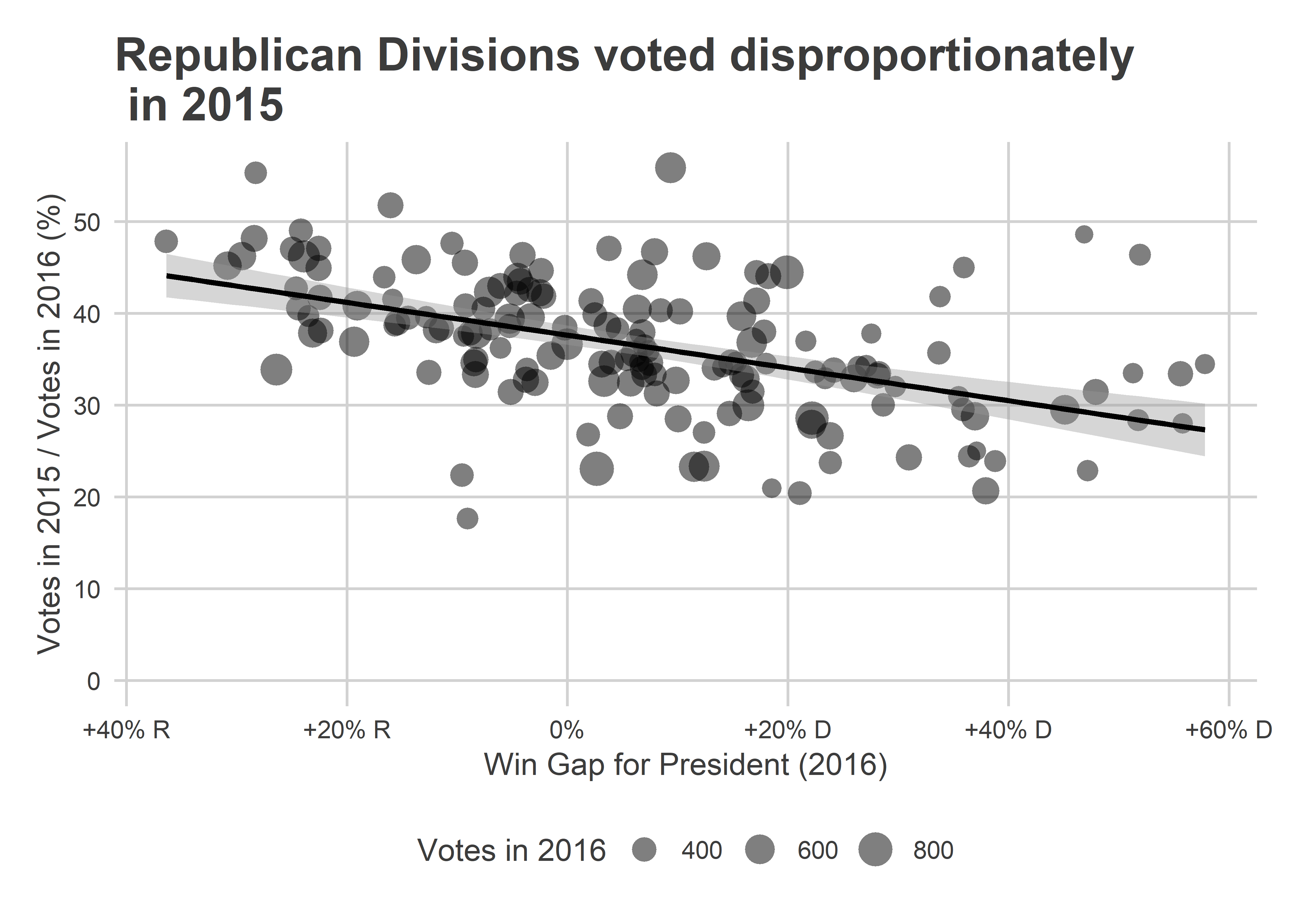
That changed in 2018. The gap was still about ten percentage points, but at a much higher overall level. Republicans’ proportional advantage was significantly weakened.
View code
turnout_scatter(2018, "Republican Divisions had less turnout advantage\n in 2018")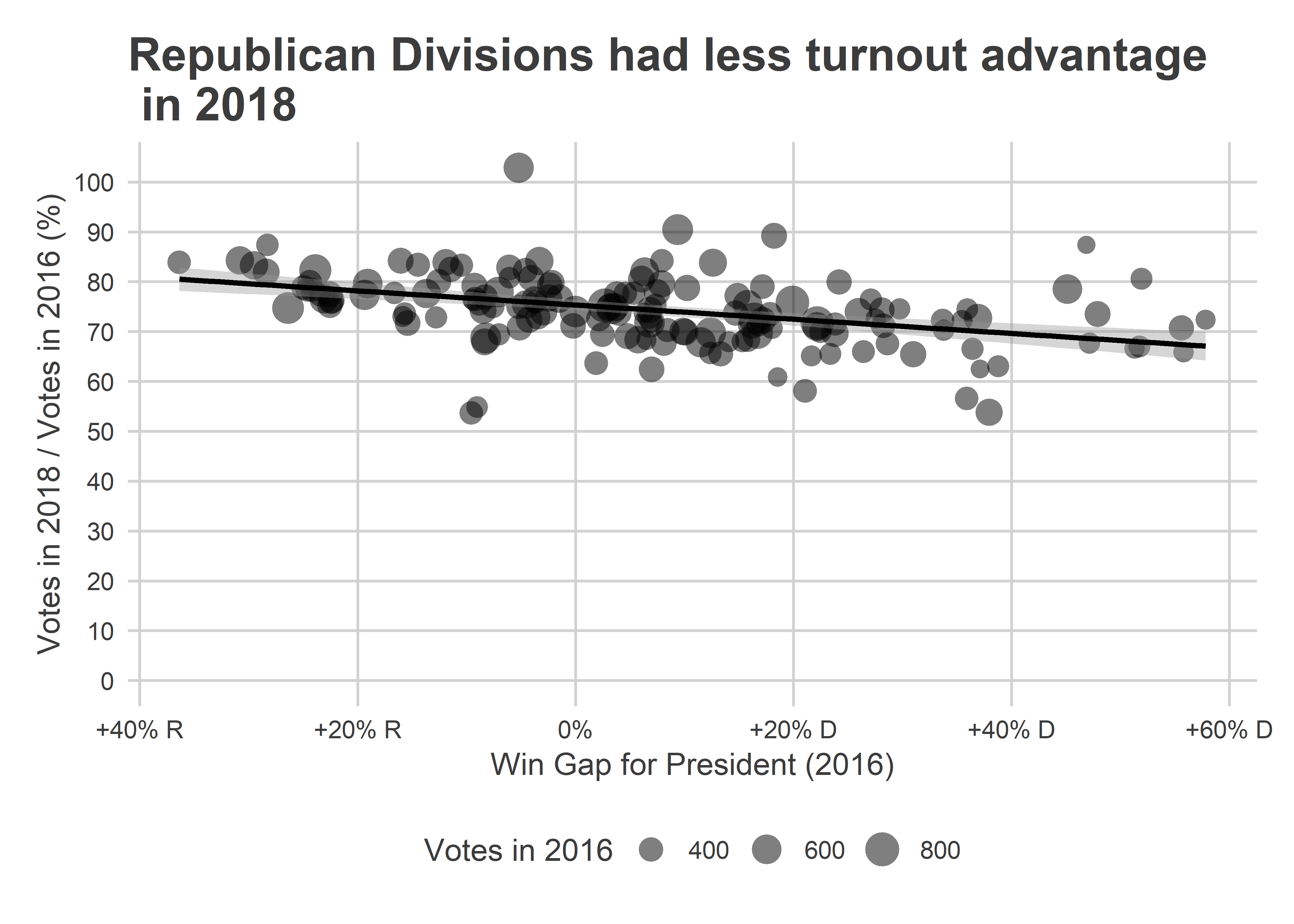
How many votes is the turnout difference between 2015 and 2018 worth? Using the division results from 2016, but turnout from 2015 and 2018, the difference between 2015 and 2018 would have been a gap of 1.2 for the Democrat. Not enough to change the results in all but the closest of races.
View code
turnout_wide %>%
left_join(d10_scatter) %>%
summarise(
gap_2015=weighted.mean(President_2016_win_gap, w=turnout_2015),
gap_2016=weighted.mean(President_2016_win_gap, w=turnout_2016),
gap_2018=weighted.mean(President_2016_win_gap, w=turnout_2018)
)## # A tibble: 1 x 3
## gap_2015 gap_2016 gap_2018
## <dbl> <dbl> <dbl>
## 1 3.44 5.35 4.60Moore needs to hope that even City Council has become nationalized.
Really the only way Moore can win is if the divisions that regularly vote for Democrats, the divisions that carried Kenney and Clinton and Boyle to victory, turn against O’Neill. This is increasingly happening across the country, but O’Neill has a big cushion.
Maybe, just maybe, Boyle’s decisive 2018 win was a sign of a changing district. The only way to know for sure would be polling. Without that, we’ll see in November.
